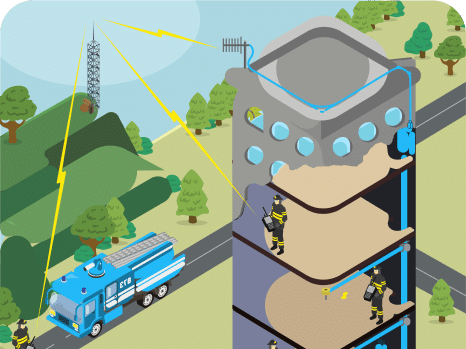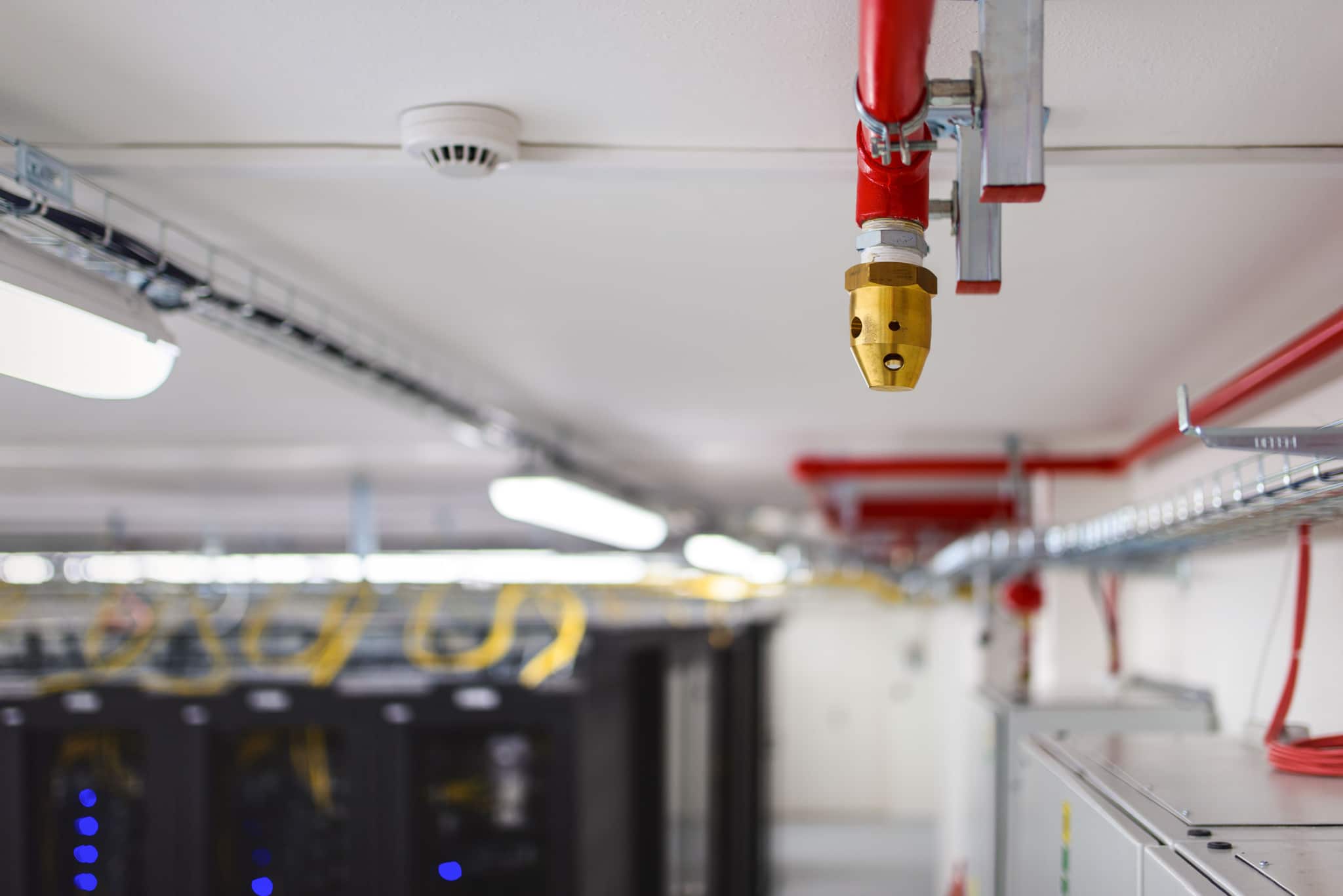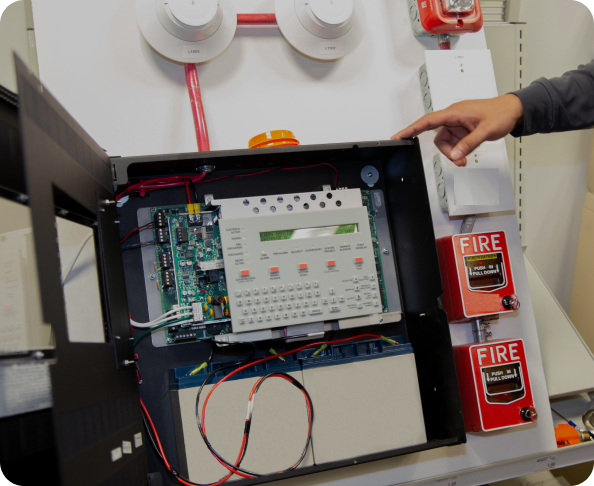What is a BDA DAS / ERCES?
In an emergency it is imperative that first responders can communicate clearly and without interruption. Any failure in communication increases the chances of injuries or deaths, the loss of valuable physical assets and the building itself. However, due to a building’s type and size, signal attenuation, construction materials, and the impact of the emergency to which they are responding, radio and cellular communications are often compromised or impossible. A bi-directional amplifier or BDA allows first responders to communicate effectively during an emergency. It is a way to enhance first responders’ communications in an Emergency Responder Communications Enhancement System (ERCES).
A BDA amplifies wireless signals (radio frequency or cellular). It extends signal range, and rebroadcasts it throughout a building or complex via a Distributed Antenna System (DAS). It ensures first responders can hear and be heard reliably in an emergency, much like how commercial security systems are designed to ensure comprehensive protection across large facilities. While many components of an ERCES contribute to effective communications for first responders, a BDA DAS is key to maintaining consistent, accurate two-way communications throughout an entire building or location.
Simply put, a fully functional BDA DAS helps save lives and protect valuable assets.
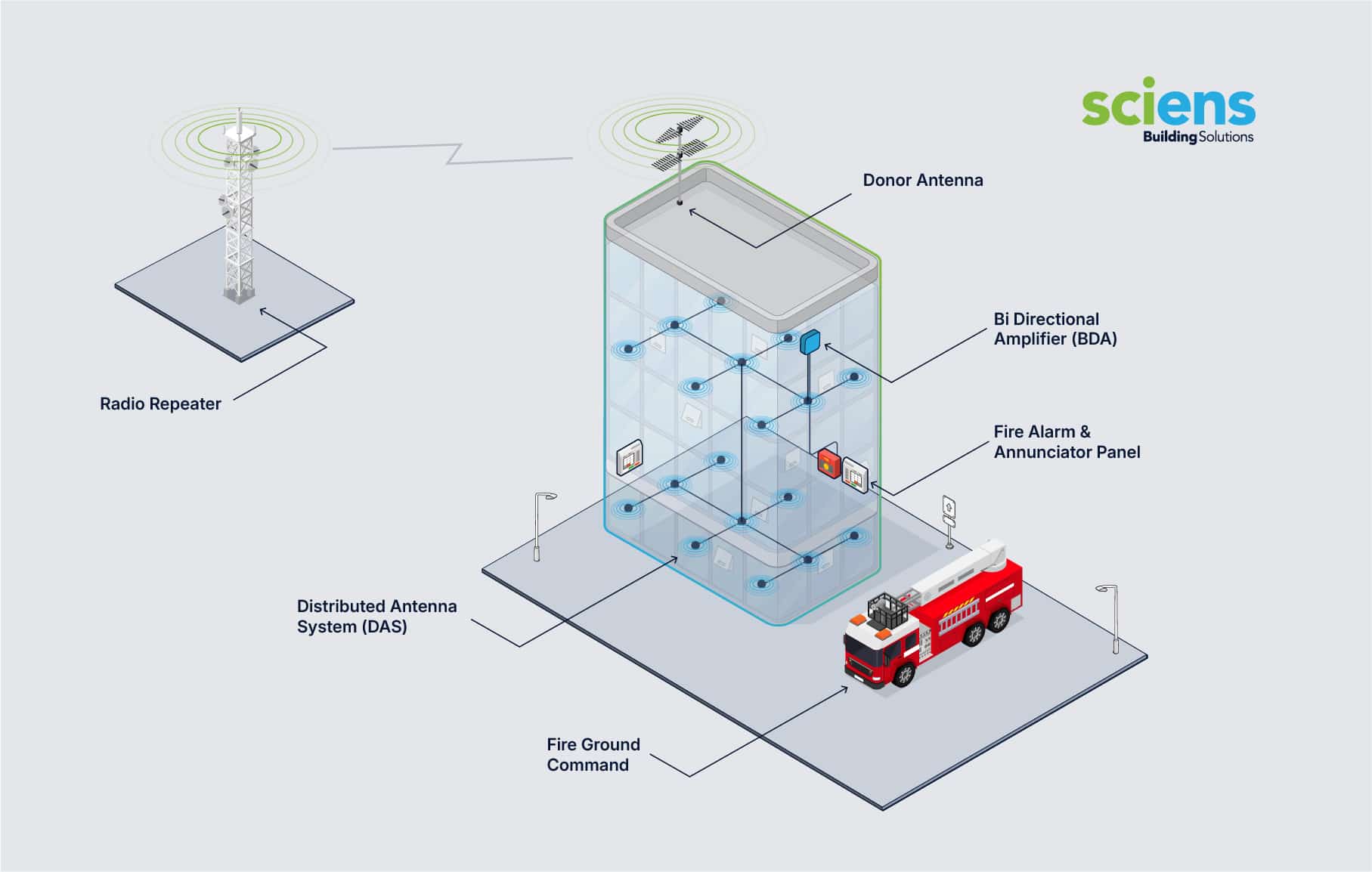
Understanding and Components of BDA Systems
A BDA DAS starts with a Donor Antenna, typically located at the highest point of a building. The BDA receives radio transmissions from the donor antenna (via cable). The BDA amplifies and sends the signal to the DAS, which consists of multiple, strategically placed antennas, splitters, couplers and tappers, along with additional amplifiers (via fiber), as needed. The amplified signal allows emergency personnel inside and outside the building to communicate more effectively.
ERCES includes several intertwined components. These include:
Dedicated monitoring panel: Every ERCES has its own dedicated annunciator panel that is separate from the fire alarm system. This panel provides information on the BDA, such as the status of AC or backup power, donor antenna integrity, battery back-up charging capability, and low battery back-up voltages.
Donor antenna: The donor antenna receives inbound signals from emergency networks Donor towers or cell towers. It connects to the BDA via a backbone coax run.
Amplifiers: BDA amplifies/boosts weak radio signals, which is key for large, multi-floor structures, tunnels, underground areas, and stadiums. The increased power offsets lost signal strength of a transmission.
Indoor Antennas: A DAS ensures complete coverage within a structure. Indoor Antennas must be placed strategically throughout the building(s) so first responders have clear reliable communication no matter where they are located within. There are different types of indoor antennas available to suit the needs of the location’s infrastructure. Some of these are OMNI-directional, Directional, low-profile (for aesthetics), etc.
Battery Back-up Unit (BBUs): Uninterrupted communications are vital, so all BDAs are required to have dedicated uninterrupted power supply for continuous operational readiness.
RF Signal Filters: If required RF Signal filters enhance and isolate emergency personnel transmissions. It also helps reduce noise in the system that can be transmitted back to the Donor Tower.
Signal failure alarms: These alert first responders when components of the system start to fail.
Often, terms like BDA DAS, BDA radio, BDA fire alarm, or BDA system fire alarm are used, but these all refer to BDA DAS or parts of a more comprehensive ERCES.
Types and Applications of BDA Systems
BDA DAS / ERCES are typically available in two types – full-duplex and half-duplex. A full-duplex system has the capability to transmit and receive signals simultaneously on different frequencies. A half-duplex system can only transmit and receive signals one at a time due to utilization of one frequency. Furthermore, an ERCES can either be narrowband /channelized (Class A) or broadband (Class B). Class A means only certain frequencies are amplified while a Class B amplifies a range of frequency.
Selecting the type BDA DAS equipment depends upon many factors, such as size/height of a building, floorplan, construction materials, what it’s used for, and how it is used. For instance, a storage warehouse may require a different BDA system than a hospital or high-rise office building.
BDAs are now mandatory in any new construction or existing structures that require public safety permits – basically anywhere people gather for work or leisure. This includes:
- Office buildings/complexes
- College campuses
- Condominiums and apartment buildings
- Stadiums
- Government buildings
- Hospitals
- Senior living facilities
- Hotels
- Airports
- Factories, warehouse, and shipyards
- Parking garages
- Commercial and retail buildings
- Shopping malls
If you’re in a larger building or structure outside your home, and it is a fairly new structure, it will most likely have an ERCES installed already.
The reason an ERCES is required in most public buildings is simple – the system saves lives and property. Key benefits of an ERCES include:
Enhanced public safety: If first responders can properly communicate anytime and anywhere in a structure during an emergency, they are better able to get people to safety, neutralize or contain the emergency, mitigate property damage, and remain safe themselves.
Compliance with regulations: Most new constructions and renovations of existing buildings now require BDA systems and must be installed by licensed professionals. A BDA system must be UL 2524 certified and compliant with NFPA 72, NFPA 1221/1225 or IFC 510 along with state and local amendments to these code standards.
Reliable communication: Past tragedies like 9/11 have taught us that our first responders must be able to communicate at all times. While the actual situation and emergency will impact their ability to communicate, the building itself shouldn’t be part of the problem. Rather it should be part of the solution. A BDA DAS/ERCES gives first responders the communication platform they need most – one that is reliable, consistent, and durable.
Future-proofing infrastructure: Advancements in construction techniques and materials will continue to define how buildings are designed and built. A BDA DAS/ERCES study must be integrated early in any construction to discover and counteract elements that may negatively impact RF signals, such as Low-E glass and other technologies that have yet to be incorporated into the building.
Peace of mind: Anyone who is present in a building during an emergency benefits from a BDA DAS/ERCES.
- Individual responsible for the safety of people inside a building
- Building and business owners
- Onsite security and building management personnel
- First responder to the location
Choosing and Implementing the Right BDA System
The selection of the components of a BDA DAS/ERCES that is appropriate for your needs will be guided by the building/complex, location, and its purpose. A high-rise office building with hundreds of occupied rooms may need a different system than a warehouse or shipyard. When choosing a system, things to consider include:
Coverage: NFPA and IFC codes are very specific on how much of the location needs coverage and to what extent. A licensed professional team will measure signal strength throughout a building to determine where ERCES components are placed and how many to place. An underground parking garage or government building may require more antennas than an outdoor stadium or shopping center.
Selecting the right equipment: Make sure all the components of an ERCES are built by reputable companies and compliant with regulations and industry standards. Remember, the system must be able to withstand the impact of the emergency itself, such as high heat, water, and potential implosion/collapse.
Compatibility: If a BDA DAS is being integrated into an existing ERCES, it must be compatible with installed equipment, such as battery backup units, control panels and annunciators, as well as radio frequencies used by local public safety agencies/jurisdictions
Scalability: A BDA DAS/ERCES should be able to scale with the future needs of the building, renovations, additions, and how the space is used. Many systems are modular and seamlessly accommodate additional antennas and amplifiers.
Remote monitoring: Being able to remotely monitor a BDA system saves time and money, so consider a system that has remote diagnostic features, monitoring, and troubleshooting. Be proactive in the long-term upkeep of the system.
Maintenance: A BDA DAS/ERCES has requirements for annual and 5-year inspections. Maintenance and replacement of parts should be considered into the equation of maintaining the system.
When it comes to installation of BDA system and/or integrating it into a more comprehensive ERCES, consider the following:
Installation: Start with effective planning and a detailed RF and CX survey report. This is essential in determining antenna and amplifier placement, cable routing, and the location of monitoring and control panels. Factors to consider include the building floor plan, potential interference issues, hazards, access to areas of the building, Donor Tower location, power requirements and environmental factors.
Compliance: Ensure the system is compliant with fire codes, NFPA requirements, FCC guidelines, and local regulations, including integration with your commercial fire alarm system. Documentation is critical, both in obtaining permits and certifications and also in providing and maintaining detailed records and documentation during the installation process.
Testing: Testing and quality assurance should be done at all stages of installation in conjunction with a comprehensive testing plan. Engage a third-party service to validate testing. Initial, annual and 5-year inspections are the minimum requirement per NFPA codes. More testing/inspection occurrences can happen depending on jurisdictional/local code amendments/requirements.
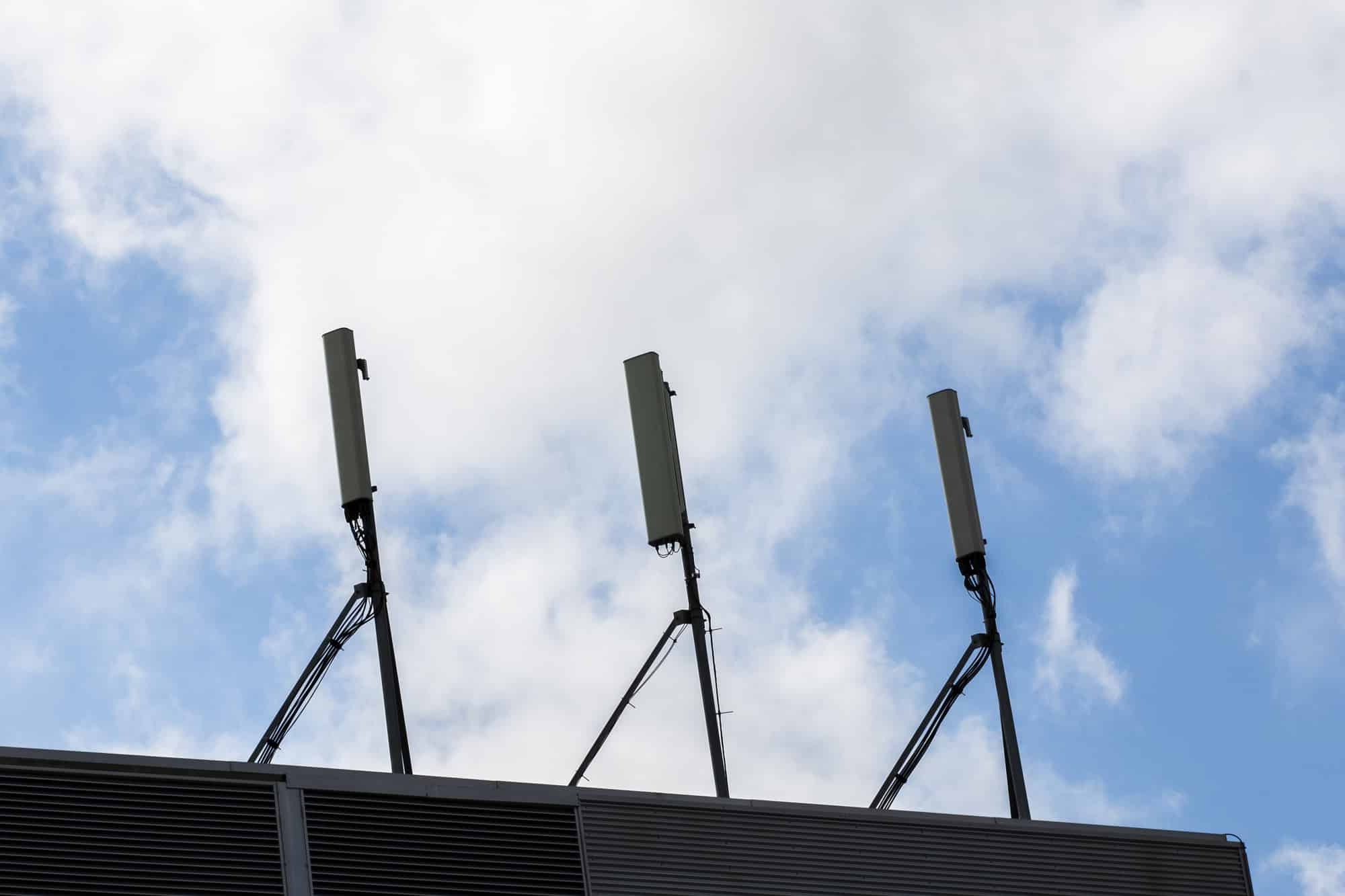
Training: The staff of the BDA DAS/ERCES location must know how it works. They will need a training program and support materials that includes how to operate the system, emergency protocols, troubleshooting and maintenance procedures and documentation on all components. Ideally, a staff will be trained according to their job, such as security staff, building managers, cleaning/maintenance crews, and other selected personnel. Each may play a different role in the event of an emergency.
Saving lives and protecting valuable assets in emergency situations is paramount for first responders. A BDA DAS enhances the ability of first responders to fulfill this mission, working in conjunction with fire protection services to ensure full safety coverage in emergencies. The ongoing effectiveness of this system requires meticulous planning, the right equipment, precise implementation, effective maintenance and adherence to regulations.
The expert team of professionals at Sciens will work with you to customize the appropriate BDA system for your needs and ensure your building and staff are prepared to be part of the solution in the event of an emergency. Contact us today for your free survey.
